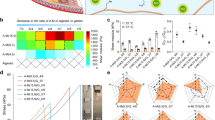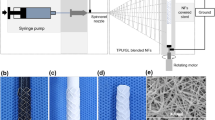Abstract
We previously demonstrated that DNA–polylactic–polyglycolic acid (PLGA)-coated stents can deliver genes to the arterial wall with reporter expression involving 1% of neointimal cells. The present study investigated a novel formulation utilizing denatured collagen in DNA-stent coatings; denatured collagen was hypothesized to enhance gene transfer due to adhesion molecule interactions and actin-related mechanisms. Arterial smooth muscle cells (SMCs) cultivated on denatured collagen had significantly greater plasmid DNA (β-galactosidase) transfection than SMC grown on native collagen (18.3±1.2 vs 1.0±0.1%, P<0.001). The denatured-collagen effect was completely blocked with anti-αvβ3 integrin antibody. SMCs cultivated on native collagen supplemented with tenascin-C (TN-C), a protein recognized by αvβ3 integrins, showed a 33-fold increase in transfection compared to control (P<0.001); this effect was also blocked with anti-αvβ3 antibody. We observed that cells grown on denatured collagen had marked F-actin-enriched stress fibers and intense perinuclear G actin, compared to those grown on native collagen, which demonstrated F-actin-enriched focal adhesions without perinuclear G-actin localization. Cytochalasin-D, an F actin depolymerizing agent, caused significantly increased SMC transfection in cells cultivated on native collagen compared to control cells (18.0±1.8 vs 3.02±0.9%, P<0.001) further supporting the view that actin-related cytoskeletal changes influence transfection. A denatured-collagen–PLGA composite vascular stent coating similarly resulted in increased plasmid DNA green fluorescent protein (GFP) expression compared to controls (P<0.001) in SMC cultures; the increased transfection was blocked by anti-αvβ3 antibody. Pig coronary studies comparing denatured-collagen–PLGA-coated stents containing plasmid DNA (encoding GFP) to coated stents without DNA demonstrated 10.8% of neointimal cells transfected; this level of expression was almost an order of magnitude greater than previously reported with a DNA delivery stent. It is concluded that denatured collagen incorporated into plasmid DNA-stent coating formulations may increase the level of gene expression in vitro and in vivo because of integrin-related mechanisms and associated changes in the arterial smooth muscle cell actin cytoskeleton.
This is a preview of subscription content, access via your institution
Access options
Subscribe to this journal
Receive 12 print issues and online access
$259.00 per year
only $21.58 per issue
Buy this article
- Purchase on Springer Link
- Instant access to full article PDF
Prices may be subject to local taxes which are calculated during checkout






Similar content being viewed by others
References
Klugherz BD et al. Gene delivery from a DNA controlled-release stent in porcine coronary arteries. Nat Biotechnol 2000; 18: 1181–1184.
Collins L et al. In vitro investigation of factors important for the delivery of an integrin-targeted nonviral DNA vector in organ transplantation. Transplantation 2000; 69: 1168–1176.
Jenkins RG et al. An integrin-targeted non-viral vector for pulmonary gene therapy. Gene Therapy 2000; 7: 393–400.
Kibbe MR et al. Optimizing cardiovascular gene therapy: increased vascular gene transfer with modified adenoviral vectors. Arch Surg 2000; 135: 191–197.
Wickham TJ, Carrion ME, Kovesdi I . Targeting of adenovirus penton base to new receptors through replacement of its RGD motif with other receptor-specific peptide motifs. Gene Therapy 1995; 2: 750–756.
Jones PL, Jones FS, Zhou B, Rabinovitch M . Induction of vascular smooth muscle cell tenascin-C gene expression by denatured type I collagen is dependent upon a beta3 integrin-mediated mitogen-activated protein kinase pathway and a 122-base pair promoter element. J Cell Sci 1999; 112: 435–445.
Jones PL, Jones FS . Tenascin-C in development and disease: gene regulation and cell function. Matrix Biol 2000; 19: 581–596.
Jones FS, Jones PL . The tenascin family of ECM glycoproteins: structure, function, and regulation during embryonic development and tissue remodeling. Dev Dyn 2000; 218: 235–259.
Jones PL, Crack J, Rabinovitch M . Regulation of tenascin-C, a vascular smooth muscle cell survival factor that interacts with the alpha v beta 3 integrin to promote epidermal growth factor receptor phosphorylation and growth. J Cell Biol 1997; 139: 279–293.
Montgomery AM, Reisfeld RA, Cheresh DA . Integrin alpha v beta 3 rescues melanoma cells from apoptosis in three-dimensional dermal collagen. Proc Natl Acad Sci USA 1994; 91: 8856–8860.
Yamamoto M, Yamato M, Aoyagi M, Yamamoto K . Identification of integrins involved in cell adhesion to native and denatured type I collagens and the phenotypic transition of rabbit arterial smooth muscle cells. Exp Cell Res 1995; 219: 249–256.
Klugherz BD et al. Gene delivery to pig coronary arteries from stents carrying antibody-tethered adenovirus. Hum Gene Ther 2002; 13: 443–454.
Stouffer GA et al. Beta3 integrins are upregulated after vascular injury and modulate thrombospondin- and thrombin-induced proliferation of cultured smooth muscle cells. Circulation 1998; 97: 907–915.
Srivatsa SS et al. Selective alpha v beta 3 integrin blockade potently limits neointimal hyperplasia and lumen stenosis following deep coronary arterial stent injury: evidence for the functional importance of integrin alpha v beta 3 and osteopontin expression during neointima formation. Cardiovasc Res 1997; 36: 408–428.
Brown SL, Lundgren CH, Nordt T, Fujii S . Stimulation of migration of human aortic smooth muscle cells by vitronectin: implications for atherosclerosis. Cardiovasc Res 1994; 28: 1815–1820.
Liaw L et al. The adhesive and migratory effects of osteopontin are mediated via distinct cell surface integrins. Role of alpha v beta 3 in smooth muscle cell migration to osteopontin in vitro. J Clin Invest 1995; 95: 713–724.
Lazarides E, Lindberg U . Actin is the naturally occurring inhibitor of deoxyribonuclease I. Proc Natl Acad Sci USA 1974; 71: 4742–4746.
Levy RJ et al. Localized adenovirus gene delivery using antiviral IgG complexation. Gene Therapy 2001; 8: 659–667.
Acknowledgements
We thank Ms Jennifer LeBold for her assistance in preparing this manuscript. This research was supported by NIH Grant HL-72108, an American Heart Association Fellowship (IP), and the William J Rashkind Endowment of the Children's Hospital of Philadelphia.
Author information
Authors and Affiliations
Rights and permissions
About this article
Cite this article
Perlstein, I., Connolly, J., Cui, X. et al. DNA delivery from an intravascular stent with a denatured collagen-polylactic-polyglycolic acid-controlled release coating: mechanisms of enhanced transfection. Gene Ther 10, 1420–1428 (2003). https://doi.org/10.1038/sj.gt.3302043
Received:
Revised:
Accepted:
Published:
Issue Date:
DOI: https://doi.org/10.1038/sj.gt.3302043
Keywords
This article is cited by
-
Physical and mechanical cues affecting biomaterial-mediated plasmid DNA delivery: insights into non-viral delivery systems
Journal of Genetic Engineering and Biotechnology (2021)
-
PLGA nanoparticles co-delivering MDR1 and BCL2 siRNA for overcoming resistance of paclitaxel and cisplatin in recurrent or advanced ovarian cancer
Scientific Reports (2018)
-
Percutaneous Approaches for Efficient Cardiac Gene Delivery
Journal of Cardiovascular Translational Research (2013)
-
Gene delivery technologies for cardiac applications
Gene Therapy (2012)
-
Gene-eluting stents: non-viral, liposome-based gene delivery of eNOS to the blood vessel wall in vivo results in enhanced endothelialization but does not reduce restenosis in a hypercholesterolemic model
Gene Therapy (2012)



